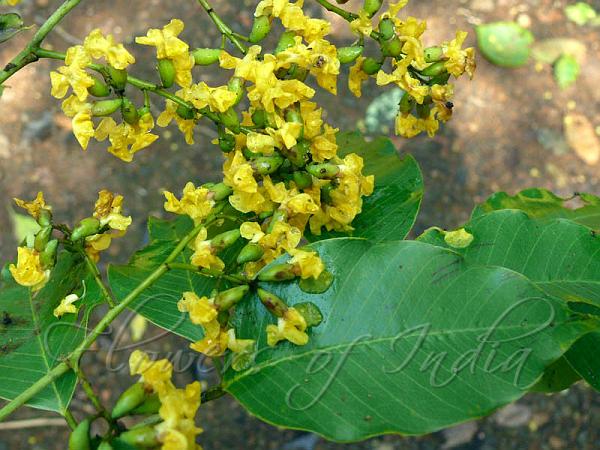|
| Indian Kino Tree |
|

|

| File size | 196210 |
| Original date | 11/14/09 5:26 PM |
| Resolution | 800 x 600 |
| Flash | Flash did not fire, auto |
| Focal length | 7.4mm |
| Exposure time | 1/160s |
| Aperture | 4.0 |
| Focus Distance | |
| Metering Mode | Multi-segment |
| Camera make | Panasonic |
| Camera model | DMC-FZ50 |
| Sensor type | OneChipColorArea |
|
|
|
|
Photo: |
Botanical name: Pterocarpus marsupium Family: Fabaceae (Pea family)
Synonyms: Pterocarpus bilobus, Lingoum marsupium
Synonyms: Pterocarpus bilobus, Lingoum marsupium
Indian Kino Tree is a deciduous tree, up to 30 m
tall, bark 10-15 mm, surface grey or greyish-black, rough, deeply
vertically cracked, exfoliations small, irregular, fibrous; blaze pink;
exudation blood-red. Leaves are compound, alternate; stipules small,
lateral, falling off; axis 6.5-11.1 cm long, slender, hairless.
Leaflets are 5-7, alternate, estipulate; leaflet-stalk 6-10 mm,
slender, hairless; blade 3.5-12.5 x 2-7 cm, elliptic-oblong,
oblong-ovate or oblong, base blunt or pointed, tip blunt and notched,
margin entire, hairless, leathery; lateral nerves 9-20 pairs, parallel,
prominent. Flowers are bisexual, yellow, at branch-ends and in
leaf-axils, borne in panicles; 1.0-1.2 cm long; bracts small,
dioecious; bracteoles 2, falling off; sepal tube bell-shaped, sepals
short, the upper 2 often fused; flowers are protruding; petals 5, all
long-clawed, crisped along the margins; standard round, wings oblique,
obovate, eard; keel petals oblique, small, slightly fused; stamens 10.
Fruit is a pod, 2.5-5 cm across, round-kidney-shaped, broadly winged;
seed one, somewhat kidney-shaped. Indian Kino Tree is found in
Peninsular India and Sri Lanka.
Flowering: September-October.
Medicinal uses: Parts of the Indian Kino Tree
(heart wood, leaves and flowers) have long been
used for their medicinal properties in Ayurveda.
The heart wood is used as an astringent and in the
treatment of inflammation. The wood and bark of
the tree are known for their anti-diabetic activity.
Parts of the Indian Kino Tree
(heart wood, leaves and flowers) have long been
used for their medicinal properties in Ayurveda.
The heart wood is used as an astringent and in the
treatment of inflammation. The wood and bark of
the tree are known for their anti-diabetic activity.
Medicinal uses:
 Parts of the Indian Kino Tree
(heart wood, leaves and flowers) have long been
used for their medicinal properties in Ayurveda.
The heart wood is used as an astringent and in the
treatment of inflammation. The wood and bark of
the tree are known for their anti-diabetic activity.
Parts of the Indian Kino Tree
(heart wood, leaves and flowers) have long been
used for their medicinal properties in Ayurveda.
The heart wood is used as an astringent and in the
treatment of inflammation. The wood and bark of
the tree are known for their anti-diabetic activity.
| Identification credit: Neil Soares | Photographed in SanjayGandhi National Park, Mumbai. |
• Is this flower misidentified? If yes,